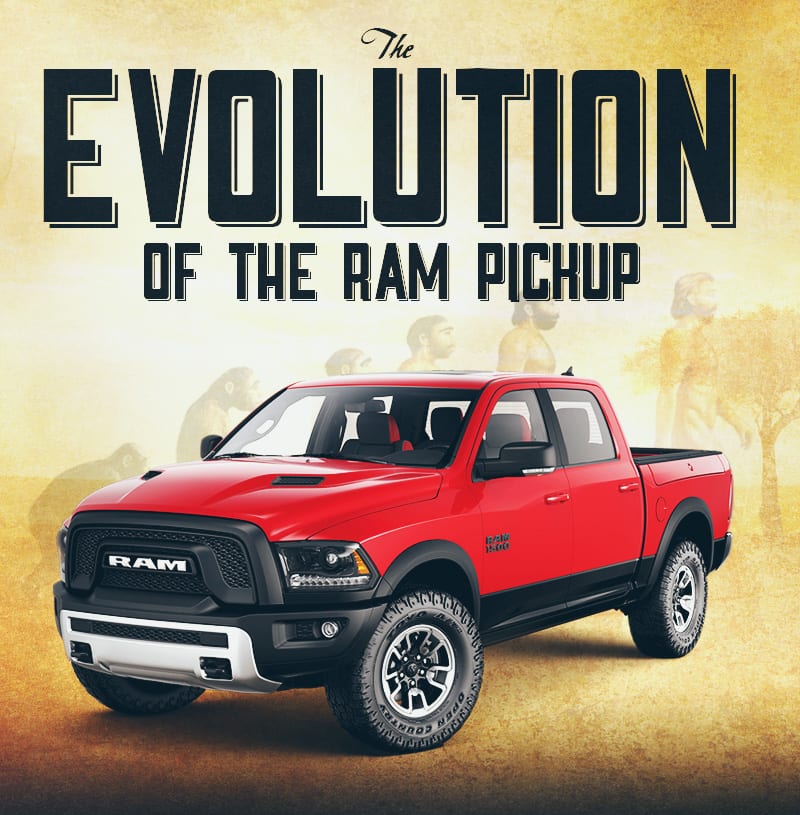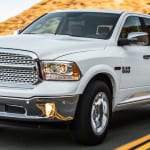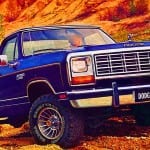The Ram pickup has evolved drastically over its 30-plus years on the market. The truck’s engineers have always been willing to test the limits and be innovative with their designs, and that’s consistently made the brand a hit on the pickup market.
If you’ve been thinking about searching for a Dodge Ram for sale, it’s important to understand where the current crop of trucks originated. Let’s take a brief history lesson and see how the pickups have evolved over the years…
First Generation
Following the retirement and rebadging of the D Series pickup trucks and the brand’s B-series vans, Dodge was looking to cement their place in the segment with a brand-new vehicle. That led to the development of the Ram trucks, and after years of the development, the pickups finally made their debut in 1981. While many fans assume the name was derived from the vehicle’s “ram-like” power and ruggedness, it was actually inspired by the Ram hood ornament found on various Dodge vehicles since 1933. The name just happened to appropriately fit the attributes of the rugged and tough pickup.
Following Ford’s lead, Dodge designated their one-half ton truck as the ‘150,’ the three-quarter ton truck as the ‘250,’ and the one-ton truck for the ‘350.’ Due to the release and subsequent popularity of the Dodge Dakota, the Ram 100 designation was replaced by the ‘150’ in 1990. The designations would evolve into the accompanying numbers we see today (1500, 2500, 3500). There were a variety of model options for the first generation, including ‘D’, ‘B’, or ‘Ram’ for two-wheel drive and ‘W’ or ‘Power Ram’ for four-wheel drive, as well as a handful of cab options (standard, “club” extended, crew).
The original Ram was essentially a revamped D-Series truck, featuring larger taillights, rectangular headlamps, and a more defined body. Under the hood, owners would find a 5.9-liter V9 engine that provided a 20-horsepower increase over the brand’s previous trucks. Those opting for the A500 could choose between the 3.9-liter V6 and 5.2-liter V8. The engine was particularly commended for its power and reliable engine during its first few years on the market.
The interior was predictably modernized over previous trucks, with engineers adding upgraded bench seats, a new dashboard, and a new instrument cluster featuring a three-pod design (which included the speedometer, ammeter, temperature gauge, fuel gauge, and oil pressure gauge).
There were several changes to the first-generation pickup throughout its 12-year run. The Club Cab was dropped only a year into the run, although it was reintroduced about a decade later. A “message center” was included in 1988, which contained a variety of warning lights, like the check engine light, ABS alert, and parking brake notification.
Sales were generally slow throughout the first generation, as Ram sold just under 100,000 units annually. With an outdated cab and chassis design and a stale interior, Dodge’s pickup ended up trailing many of its competitors, including the Ford F-Series and General Motors’ C/K Trucks.
Second Generation
In 1994, the vehicle saw a complete redesign with the release of the second-generation Rams. Development for this vehicle was a long time coming, as engineers started designing the pickup back in 1986. The truck was finalized in 1992, just in time for a 1994 release. The vehicle was intended to be released in 1991, but the relatively safe initial design didn’t impress the designers. This included chief design engineer Phillip E. Payne, who told executive Bob Lutz that the truck was a “rehash” of all the others. Payne worked tirelessly over the next six months to completely revamp the design, just enough time for the vehicle to be produced in time for the 1994 model year.
Initially described as “flat” or “sedan-like,” especially when compared to the beefy competitors, the truck included a front end that featured a large, eye-catching grille (an aspect that may remind some of a big rig). The pickup ended up being a hit, as sales jumped from 78,000 in 1993 (the final year of the first generation) to 240,000 in 1994. The numbers continue to climb, reaching 410,000 units sold in 1995 and 480,000 units sold a year later.
Now available as the 1500, 2500, and 3500, the pickup featured several interior changes. Storage features were emphasized, with engineers adding a larger glovebox, a storage area in the center armrest, and plenty of storage space behind the seat. The dash and gauge cluster were modernized, as well as the side-view mirrors. The “Crew Cab” was released in 1998, featuring “suicide” doors, rounded mirrors, a redesigned interior, and a digital odometer.
Nothing much changed in regards to the vehicle’s engine offerings, as the Ram pickup was still equipped with either the 3.9-liter V6, 5.2-liter V8, 5.9-liter V8, and 5.9-liter L I6 Cummins turbo diesel. However, customers could now opt for a non-diesel engine that provided superior pulling power in the 488-cubic-inch 8.0-liter V10 unit.
Despite the climbing sales (and the mainstream popularity brought on by the truck’s role in the movie Twister), the sales dropped off in 2000 as Ford and GM released their redesigned trucks. Only a year later, Dodge was trailing the two major companies by a solid margin.
Third Generation
Debuting at the 2001 Chicago Auto Show, the third generation Ram 1500 was released for the 2002 model year, and the 2500 and 3500 models followed a year later. There were several major overhauls to the frame, suspension, powertrain, interior and sheet metal design, as well as more specific changes, like the lack of a live axle (replaced by an independent front suspension) in the 1500.
The Mega Cab was introduced in 2006, providing owners with a 6.25-foot cargo box and an additional 22 inches of cab space. The steering wheel was replaced with a unit that more resembled the one seen in the Dodge Dakota or Dodge Durango. Sirius Satellite Radio was available, as was a rear-seat DVD entertainment system. A year later, the company rolled out their 3500 Chassis Cab, and the 4500 and 5500 Chassis Cab was released in 2008.
Similar to the previous generation, the redesign helped boost popularity, as sales jumped from 400,000 in 2001 to 450,000 in 2002. Still, the brand found themselves trailing Ford and GM, who were selling around 900,000 units annually.
Fourth Generation
Today’s generation of Rams debuted in 2009 after having been unveiled at the 2008 North American International Auto Show in Detroit. The brand added several new features to help boost sales, including a four-door cab style offering, a revamped suspension, a new Hemi engine, and the Rambox storage system.
The brand’s sales had fallen precipitously towards the end of the third generation, peaking at 449,371 units sold in 2004 and dropping to 177,268 by 2009. Luckily, sales began climbing again with the release of the fourth generation, as the brand approached 440,000 units sold in 2014.
While Ram may have trailed some of their rivals in sales throughout their 30-plus years on the market, it hasn’t been because of quality. Ram has done an admirable job of revamping their pickup whenever their product goes stale. Luckily, this generation of Rams continue to grow in popularity and sales, and we should expect the current crop of pickups to stay on the market for some time. Customers are no longer limiting themselves to major brands, and we wouldn’t be surprised if Ram continues to climb the ranks of the best-selling pickups.








